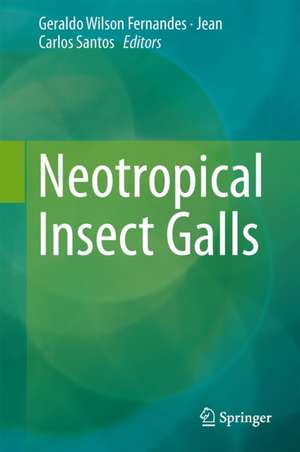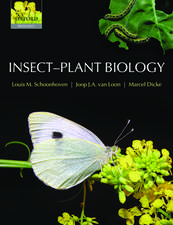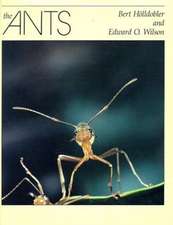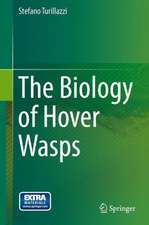Neotropical Insect Galls
Editat de Geraldo Wilson Fernandes, Jean Carlos Santosen Limba Engleză Hardback – 11 iul 2014
Preț: 956.19 lei
Preț vechi: 1166.09 lei
-18% Nou
Puncte Express: 1434
Preț estimativ în valută:
183.13€ • 188.67$ • 153.40£
183.13€ • 188.67$ • 153.40£
Carte tipărită la comandă
Livrare economică 24 februarie-10 martie
Preluare comenzi: 021 569.72.76
Specificații
ISBN-13: 9789401787826
ISBN-10: 9401787824
Pagini: 560
Ilustrații: IX, 550 p. 132 illus., 56 illus. in color.
Dimensiuni: 155 x 235 x 38 mm
Greutate: 0.96 kg
Ediția:2014
Editura: SPRINGER NETHERLANDS
Colecția Springer
Locul publicării:Dordrecht, Netherlands
ISBN-10: 9401787824
Pagini: 560
Ilustrații: IX, 550 p. 132 illus., 56 illus. in color.
Dimensiuni: 155 x 235 x 38 mm
Greutate: 0.96 kg
Ediția:2014
Editura: SPRINGER NETHERLANDS
Colecția Springer
Locul publicării:Dordrecht, Netherlands
Public țintă
ResearchCuprins
Introduction.- 1. Neotropical Insect galls: status of knowledge and perspectives; G. Wilson Fernandes et al.- 2. Developmental Anatomy of Galls in the Neotropics: Arthropods Stimuli vs. Host Plant Constraints; Rosy Mary dos Santos Isaias et al.- 3. Functional Gradients in Insect Gall Tissues: Studies on Neotropical Host Plants; Denis Coelho de Oliveira et al.- 4. Gall Morphotypes in the Neotropics and the Need to Standardize Them; Rosy Mary dos Santos Isaias et al.- 5. Population Ecology of Galling Arthropods in the Neotropics; Tiago Shizen Pacheco Toma, Milton de Souza Mendonça Jr.- 6. Bottom-up Effects on Gall Distribution; Milton Barbosa, Geraldo Wilson Fernandes.- 7. Natural selection on a tropical system: gall-size distribution on Waltheria indica L. (Malvaceae); José M. A. Figueiredo et al.- 8. Density of insect galls in the forest understorey and canopy: Neotropical, Gondwanan or global patterns?; Sérvio Pontes Ribeiro et al.- 9. Galling insects as indicators of habitat quality; Tiago Shizen Pacheco Toma et al.- 10. Host specificity of gall midges (Diptera: Cecidomyiidae) on ten species of Inga (Fabaceae); Amandine Bourg, Paul Hanson.- 11. Galling insect community associated with Copaifera langsdorffii (Fabaceae): the role of inter- and intra-annual host plant phenology; Marcilio Fagundes.- 12. Galling insects on Caryocar brasiliense Camb. (Caryocaraceae); Germano Leão Demolin Leite.- 13. Baccharis: a Neotropical Model System to Study Insect Plant Interactions; G. Wilson Fernandes et al.- 14. Galls and Galling Arthropods of southern Brazil; Milton de Souza Mendonça et al.- 15. Galling insects in the Brazilian Cerrado: Ecological patterns and perspectives; Walter Santos de Araújo et al.- 16. Galls in Brazilian mountains: new reports and perspectives; Marco Antonio A. Carneiro et al.- 17. Gallsin the Brazilian Coastal Vegetation; Valéria Cid Maia et al.- 18. Galls from Brazilian Atlantic Forest: status of knowledge and perspectives; Jean Carlos Santos et al.- 19. Galling Insects in the Pantanal Wetland and Amazonian Rainforest; Genimar Rebouças Julião et al.- 20. Galls from Brazilian Tropical Dry Forests: status of knowledge and perspectives; Marcel S. Coelho et al.- 21. Galls of the temperate forest of southern South America: Argentina and Chile; Carolina Quintero et al.- 22. Gall-Inducing Insects and Their Associated Parasitoid Assemblages in the Forests of Panama; Enrique Medianero et al.- 23. Insect galls of Costa Rica and their parasitoids; Paul Hanson et al.- 24. Mexican gall-inducing insects: importance of biotic and abiotic factors on species richness in tropical dry forest; Pablo Cuevas-Reyes et al.
Recenzii
“This book comprises 24 chapters that reveal an array of research on physiology, ecology, and diversity of neotropical galls. … For gall enthusiasts and researchers of plant-insect interactions, this book would be good addition to their library. The volume highlights interesting tropical research that may not be familiar to scientists from temperate parts of the world.” (John Tooker, The Quarterly Review of Biology, Vol. 90 (2), June, 2015)
Textul de pe ultima copertă
This book focuses on one of the most sophisticated guild herbivorous insects, the gall inducing insects. They trespass the defensive lines of their host plants, engineer the host to provide their larvae with shelter against the external harsh environment and natural enemies and in addition provide better food to their larvae. Not surprisingly the gall is often regarded as an extended phenotype of the inducing insect. The reader will find in this book the most updated ecological and evolutionary information on the biogeopgraphy of galling insects in the New World Tropics. Topics range from the very first reactions of the host plant cells to the gall inducing larvae up to the natural enemies that control galling populations, including galling insect relationships with habitats that ultimately result in their spatial distribution and diversity. The book also addresses many important questions in galling studies, such as the role of superhosts, the host plant defenses to galling, and the importance of habitat harshness at the canopy of rain forests, among many other issues. Finally, the book also describes the galling richness in many different Neotropical vegetation types. The reader will find that the information depicted helps to challenge former hypohteses on their geography and diversity, provides new syntheses and open new perspsectives for the study of this spectacular herbivore guild.
Caracteristici
The sole compendium on the ecology of tropical gall inducing insects Brings to light and to main stream ecology the most recent findings on the study of insects in the tropics Highlights the most recent findings on gall inducing insects and their host plants in the Neotropics Includes supplementary material: sn.pub/extras













